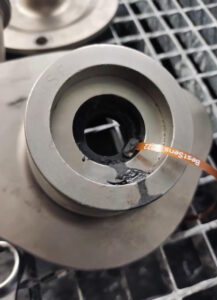Seals, especially mechanical seals in pumps, play a critical role in a wide range of industrial applications, from food processing to chemical processes. Damaging events such as evaporation and particles in the seal gap can not only affect the efficiency of these applications, but also lead to costly failures and repairs. But how can these damaging events be detected in the running process?
Application engineer Philipp Arneth shows how these damaging events can be identified using tests on the BestSens AG test stand. A centrifugal pump with a silicon carbide mechanical seal and water as pumping medium was used for the test setup. By integrating the multisensor into the mechanical seal and using the BestSens measuring system, online condition monitoring is possible at any time.
“By monitoring the mechanical seal with our ultrasonic technology, it is easy to see the current condition of the seal during operation. If, for example, evaporation of media occurs in the seal gap, this is reflected in the measurment data,” explains Arneth. Figure 1 illustrates this effect: The lubricant, in this case water, changes from a liquid to a gaseous state. This then leads to insufficient lubrication and solid contact in the gap. This operating condition alone already damages the seal, but it is also an effect that can be followed by many different damage processes. These effects can occur in processes where gases are dissolved in liquids (e.g. carbon dioxide in beverages) or in processes with high temperatures or a pressure difference upstream and downstream of the seal (e.g. with highly volatile substances in chemical processes).

To demonstrate the effects of these damaging processes, the media temperature was influenced by varying the rotation speed of the pump. Arneth is satisfied with the results: “Here you can see very clearly the evaporations in the seal and the seal condition outside the defined standard range.”
In order to simulate other failures like particles in the seal. In the first phase of the measurement, the pump was operated without particles and the seal was in “good condition” (Figure 1). After about three days, in the next phase of the experiment, boron nitride (boron nitride powder; used for lapping sealing surfaces) was added as an abrasive medium to intentionally damage the sliding surfaces. The suspension of water and boron nitride gets between the sliding surfaces after a short time in operation, thus causing artificially induced damage and a drastically increased wear of the mechanical seal. The BestSens system immediately detects the change in the lubricant film, which is noticeable in the increased characteristic value ‘Reciprocal Variation’. The ‘Reciprocal Variation’ is a specially calculated characteristic value of the SAW (Surface Acoustic Waves – guided acoustic waves) and describes, roughly summarised, the shift of the transmission time of individual acoustic pulses depending on the lubricant film condition.
Due to leakage occurring at the damaged seal, the water quantity decreased, which after a short time led to insufficient lubrication and subsequent dry running of the mechanical seal. The boron nitride was then removed again by repeated cleaning. The worn seal continued to be operated over the course of the next few days with insufficient lubrication until it ran dry.

Based on these acoustic measured variables, damaging events and wear can be detected in the measurement data. The tests on the test bench show a simplified picture of the processes in the field, but already underline that sealing problems in the running application can be detected with the measurement.

BestSens AG specialises in ultrasonic-based monitoring of mechanical seals and other rotating components to detect and indicate wear and anomalies early in the process. This can reduce unplanned downtime, optimise maintenance costs and increase plant safety. By integrating a multi-sensor into the mechanical seal and using the BeMoS measuring system, online condition monitoring is possible at any time. Further investigations and measurements on the BestSens AG test stand are already planned.












